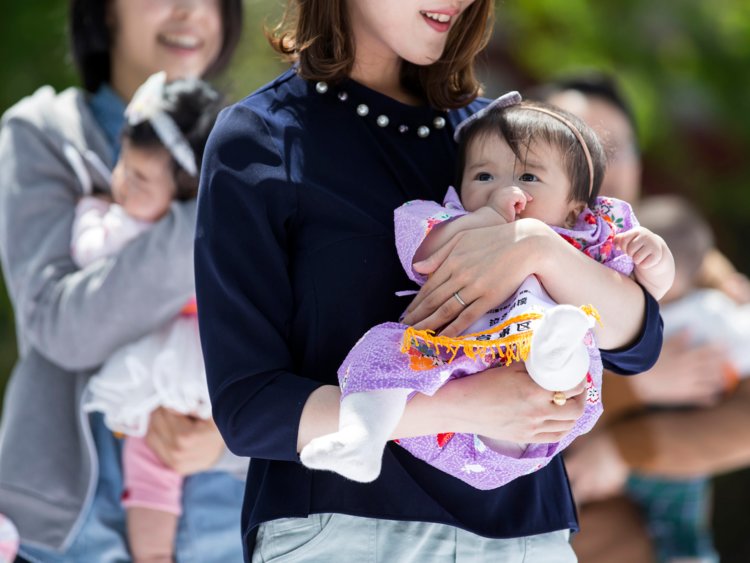The childcare crisis facing Japan’s working moms

]]]]>]]>
Instead, she set off a confrontation.”They were telling me like, ‘No, you cannot stay here’ and, ‘Leave the chamber immediately with your baby.’ Those words really shocked me,” Ogata said. One councilman even began shouting at her. Ogata was eventually forced to leave and only allowed to return after she had left her son with a friend. While globally other politicians, such as US Senator Tammy Duckworth and New Zealand Prime Minister Jacinda Ardern, have been celebrated for bringing their babies into the halls of power, Ogata’s experience, in 2017, highlights Japan’s struggle with mothers in the workplace. The government of conservative Prime Minister Shinzo Abe has spent 6 years encouraging women to join the workforce, promoting the idea as a way to drive economic growth in a country with an aging population and shrinking labor pool. About 71.3% of Japanese women in their prime working years now hold some sort of job, according to the OECD.Yet when these women join the workforce, they are confronted with the many challenges of being a working mother in Japan. Pain points include a shortage of daycare facilities, a lack of flexibility in working hours and a traditional culture that leaves women doing most, if not all, of the household chores and childcare. ]]]]>]]>This tension between what Japan wants from its working moms and the support it provides them has given rise to a new generation of activists, like Ogata, who believe the country should do better to facilitate a work-life balance for parents. Ogata felt the entire incident in 2017 was not only shocking, but a violation of her position as an elected official, a democratically chosen representative of, among other people, working moms. “There is no way anybody can tell me to leave the chamber,” she said.From Yemen to KumamotoBefore she moved back to Kumamoto, a city on the southern Japanese island of Kyushu, and decided to run for city council, Ogata worked for the United Nations in Yemen. When she came home, Ogata said she noticed life had become more stressful for many normal people. She believed the government was planning to spend more resources on defense and less on social welfare. “I didn’t want to pass that future to my children,” she said. “So, I decided to run.” She works mostly from a cluttered kitchen in her house. There are diapers on the floor and books by Mahatma Gandhi, the late leader of India’s independence movement, and Democratic presidential candidate Bernie Sanders on the shelf. At one point in our interview, her son, now 2 years old, was brought home and she started to breastfeed.Most of the changes Ogata has advocated for in Kumamoto are modest. She convinced the mayor to sometimes hold his monthly Q&A sessions on weekends instead of weekday evenings, so more moms can attend. She got city departments to put “children welcome” on flyers for more events. She is still fighting for babysitting services at City Hall so mothers can fill out forms without distraction. Moms from other politicians’ districts come to her when they have problems. “I would like our city or our society to accept a diverse way of raising children, or balancing work and raising children,” she said. That could mean parents putting children in nursery schools or daycare, but also being able to bring their offspring to work, if they want to. A shortage of daycareOver a month of reporting in Japan, more than 20 parents shared their frustrations with the process of finding daycare. They described a system that’s both acutely stressful and profoundly bureaucratic. First, parents get ranked according to a complex system administered by local governments. They receive points based on things like job status, income, whether they use a babysitter or have a parent who lives with them. Those with the most points have the easiest time qualifying for their top choice public daycare or a private daycare center that is government subsidized. Sometimes they get assigned daycare on the opposite side of town, or the younger child gets a place in one location while the older child has to go to another. That’s if they get in at all. As of October, 47,198 children were on the waiting list for daycare nationwide.Frustration with this system has driven a group of parents to form an advocacy group called Miraco, dedicated to making life easier for working parents. Tae Amano, one of Miraco’s other co-founders, said it was not an easy to transition from being a working mother-of-three to being a daycare activist, especially in a society where few women participate in politics. “We are not powerless and what we are doing is not wrong,” she said. The 43-year-old started the group after her third child was rejected from all the daycare centers she applied to. The same thing had happened with her first child, eight years earlier. Miraco pressures the government to invest the time, energy and funds to end the shortage. The group created a hashtag #IWantDaycare, which went viral, and has asked parents to post their daycare rejection letters from local governments online. They organize an annual gathering of activists and politicians to hold up signs with the hashtag, and host policy forums and send surveys to politicians asking their opinions on childcare issues. Their efforts have helped make the childcare shortage an issue politicians cannot avoid. But despite the increase in public pressure, ending the daycare shortage is no easy task. The Nomura Research Institute estimates that by 2023, the country will need to add 279,000 new daycare places as more women join the workforce. This can be a tough sell in a country that has the world’s highest ratio of government debt to GDP and faces the growing burden of taking care of its aging population. OECD data shows Japan spends a lower percentage of its GDP on childcare than most other developed countries. “Care of children and elderly is thought to be a family responsibility, not a social responsibility, that means only women should do it,” said Kaori Katada, an associate professor in social policy at Tokyo’s Hosei University. There are various ways activists believe the government could increase daycare availability. The government could plow money into the private system, loosen building restrictions for daycare, such as those banning the use of high rises or those lacking outside space, or they could raise prices or subsidies, which might attract more private providers to compete.Some changes have already been implemented, such as allowing for facilities without outdoor space for children under two and experiments like allowing daycare centers to setup inside public parks.Deeper flaws in the systemExperts say Japanese women face outright discrimination in offices because they are seen as less committed due to the likelihood they will become mothers. Women who are seen to prioritize their home life over their company — by leaving at a normal time to pick up children from daycare, for example — can find themselves “mommy tracked” at the office, including being passed over for promotions and raises, said economist Machiko Osawa, director of the Research Institute for Women and Careers at Japan Women’s University. Amano, the Miraco co-founder, said she had experienced this. When she had her first child, the construction company she worked for gave her two choices: quit or be demoted to assistant level. This was in 2009. Osawa also said she believes discrimination manifests in more subtle ways. For example, Japan’s work culture has long emphasized overtime and mandatory workplace transfers, neither of which are conducive to life as a primary caregiver. She believes such practices should be banned by the anti-discrimination law. The average woman in Japan does about 3-and-a-half hours of housework and child care a day. The average man does about 45 minutes, performing less unpaid work a day than his counterpart in any other OECD country.Men who do want to help at home often find the mandatory overtime makes this near impossible. A recent study found working hours were the factor most closely correlated with this lack of male participation in the home. Men who worked more than 10 hours a day had little or no participation in child rearing. The government is trying to encourage companies to limit working hours and offer flexible options, such as working from home. “This is a sort of crossroads in Japanese society about how we want to lead life. The younger generation — they are more interested in the fulfilling life,” said Osawa.Women in powerWomen who advocate for change find few politicians of their gender to advocate to. Prime Minister Abe has just one female member in his cabinet, a fact he brushed off by saying she could do the work of two or three women. In the conservative region of Japan, where Yuka Ogata lives, a third of local councils have no female members at all. Seiji Sakata, who sits on the Kumamoto City Council with Ogata, said he believes women get “too narrow-sighted in their thinking, while men have a broader point of view.” He felt by bringing her baby to the council, Ogata was asking for a privilege not offered to other local women. Ogata rejected this view, saying her behavior was motivated by concern for the needs of other women. More than one year after she brought her baby through the council chamber doors, life is not easy for Ogata. She said she has been bullied by colleagues, including an incident where she was thrown out for sucking on a lozenge when she had a cold, an act for which she refused to apologize. Her suggestions about how to make child rearing easier for constituents are met with resistance by many. Still, Ogata did manage to get re-elected this spring.Before she joined the Kumamoto City Council, she said, there was no voice representing mothers of her generation. Now they have one and she takes that duty seriously. They can force her to leave the chamber temporarily for bringing her baby in or for using a cough drop, but as long as the voters want her there, she’s coming back in.Chie Kobayashi and Katherine Whatley contributed to this story. This story was supported by the Abe Fellowship for Journalists, a reporting grant from the Social Science Research Council and the Japan Foundation Center for Global Partnership.





